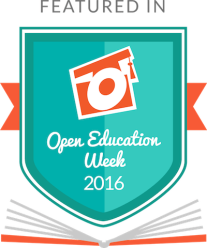I recently reread my PhD thesis (titled “Instructional interactions and online course effectiveness at a large Mexican organisation”), which I completed in 2014. I learned so much, much more than what I could write in an academic way. And I wanted to share it… So I added a prologue and an epilogue. I don’t know if that is common practice; I don’t really think it is. I did it anyway. I used the space as an opportunity to express myself as a person, with passion, dreams and hopes, to move past the formalities of scientific language and to describe the fantastic learning journey of my PhD work.
Anyway, here they are…
Prologue
My interest in designing effective online courses to help organisations provide accessible and efficient training to their staff has been present since the beginning of my professional career. I focus on Mexico because it is my home country and I am aware of our limitations, compared to more developed countries. I acknowledge the potential of technology to facilitate learning. I believe that employees who have suitable development opportunities and feel well-prepared to do their jobs are happier and more productive. Contributing to this area is my way of creating a better world. I am passionate about education and learning technologies.
While the value of online learning is widely accepted, in corporate settings, especially in developing countries such as Mexico, doubts remain. Some of these lingering questions relate to bad practices. I have personally experienced some awful, page-turner online courses. I decided to make it my mission to find engaging ways of fostering online learning.
Since 2006 I have worked in the field of corporate e-learning. I started in a large Mexican company. I was in charge of managing an online training system in the e-learning platform Moodle. I used to help managers develop the courses and support online students. I had no freedom to change the learning design. I was given a template, which had to be completed. Courses were text-based. There were no embedded interactions with other people. Every tool that fostered collaboration was blocked, due to security concerns. Communications with the teachers were infrequent, via email. I found the courses static, uninspiring and boring.
In 2009 I began working on my own as a learning consultant and realised that many organisations excluded social interactions from their online courses (e.g., Padilla Rodriguez & Armellini, 2013a; Padilla Rodriguez & Fernandez Cardenas, 2012). I found that most employees took for a fact that online courses were isolating experiences. I have had conversations with Human Resources staff in which learning designers share their beliefs that virtual courses are mostly online reading materials available for self-study that require no human support. Participants’ expectations of online courses seem to be tainted by these preconceptions.
On the other hand, I have also come across reports of online students stating that they learn more from other people and that sometimes online content cannot answer their specific questions. At organisations, usually, only one or two people require any particular training at a time. It does not make sense to have a group of students. It is unfeasible. I can understand that. Yet, I am intrigued. Are content-based online courses in organisations really effective? The organisations I worked with claimed they are. However, evaluations are often limited to satisfaction surveys and exam performance without an agreed baseline.
I am a psychologist and my master is in education and cognition. I am familiar with learning theories such as constructivism, which emphasises the role of peers and experienced others in learning. In the academic contexts I have been acquainted with, I have constantly heard of the value of team work and sharing of experiences. Animated discussions with people can make any topic exciting. Are online courses that foster social interactions effective, then? The universities I worked with claim they are. However, as in organisations, evaluations often lack a pre-post systematic approach.
The contrast between companies and academic institutions suddenly made sense when I found Anderson’s (2003a) interaction equivalency theorem and its thesis about how learning can be supported if one of three types of interactions is present at a high level. If it was supported by empirical evidence, it would explain why organisations and universities claim that their online courses are effective in spite of their differences. It could also lead the way for effective online learning designs. I decided to test this thesis. This research was conducted in a large Mexican organisation and aimed to explore the relationship between online interactions and course effectiveness.
Epilogue
When I started conversations with the participating organisation, I was focused on answering my research questions: creating groups of students, delivering different versions of the same course, evaluating interactions and effectiveness… I soon realised that if I wanted to be successful, I needed to do much more than what I had originally planned.
Helping the organisation acquire the necessary conditions to implement interactive online learning was a hard, exhausting job. The Moodle Features course, which I moderated, had over 150 students. Since it was the first online course delivered to sales supervisors at the organisation, I tried to reply to all messages. I wanted to challenge the misconception of online courses as isolating spaces. I wanted participants to know that they were not alone, that someone was reading their contributions. I had many 14-hour days.
My original plan was to redesign, develop and evaluate four online courses. I ended up assessing employees’ perceptions on e-learning, installing and configuring Moodle in the organisation’s server, negotiating expectations, training different stakeholders, creating seven courses and moderating three of them, evaluating interactions and effectiveness, presenting results to senior managers, and establishing the foundations for the project to continue beyond the completion of my thesis.
In this sense, my PhD work was a unique opportunity to systematically document the process of implementing online learning at a large Mexican organisation. While other academics have studied different topics in the area of corporate e-learning (e.g., Vaughan & MacVicar, 2004, studied employees’ pre-implementation attitudes towards e-learning; Gunawardena et al., 2010, defined predictors of learner satisfaction and transfer of learning in a corporate online education programme), few researchers have had the opportunity to work with so many different stakeholders at different stages of the implementation process. I did. Throughout the project, I worked with HR managers, HR staff, learning designers, IT staff, retailers, sales supervisors, and sales managers and directors.
My friendships within the organisation helped a lot in terms of access and support. I am grateful. I would not have been successful without their help. It was not easy. Yet, the experience I acquired, plus random expressions of enthusiasm, make it all worth it.
Lots of things have changed at the organisation. They now have a more interactive approach towards learning. They now have experience with different designs for online courses. They now know how to conduct thorough evaluations of course effectiveness, taking advantage of their existing resources and practices. They are now an example to follow for the parent corporation. They were pioneers in innovating, moving beyond the possibilities of face-to-face courses and online courses-in-a-box.
This project is only a beginning for the organisation. Learning designers are taking the lessons learned forward to improve their educational offer. It will take them a while to create an efficient learning culture and to truly empower employees to be in charge of their own development. It is a process, which will be full of challenges, but the first step is taken. I am happy to have been part of this.
While much remains to be researched, I have moved forward in my mission of helping employees feel better prepared to do their jobs and thus, creating a better world. I have also satisfied my personal curiosity and answered questions I have had since long ago. Are content-based online courses in organisations effective? Yes! Are online courses that foster social interactions effective? Yes! Anderson’s (2003a) interaction equivalency theorem seems to hold true if expanded to include course delivery. Both kinds of courses can be effective. The key is not in the type of interactions embedded in the course but rather on how these interactions take place.
I have learned more than what I can document in a formal, systematic way. I now feel confident enough to help organisations in the implementation of e-learning, from scratch. I can now foresee potential problems that may arise at different stages. I have enough experience to make decisions on the spot. I have a better understanding of how to design, implement and evaluate effective online courses. I know how different stakeholders can be crucial in the success or failure of corporate e-learning. I have evidence to justify the value of online courses to managers and other practitioners. I appreciate how online courses can change people’s attitudes towards learning and how technologies can empower employees.
It was a rewarding journey.

 As part of my post-doc research at
As part of my post-doc research at 